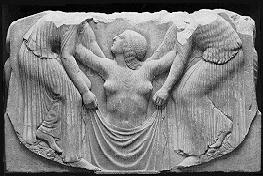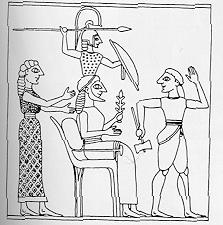| It has been suggested that the Ludovisi Throne relief shows a birth scene venerating Eileithyia, the goddess of childbirth. |
 |
The central figure of the Ludovisi Throne could be kneeling in the throes of childbirth, which would account for the emphatic way the veil is held in front of the figure. However, this would leave no room for the figure's spread thighs, but this perhaps was not a consideration for the male sculptor. The figures in the side panels could carry the same implications as if the goddess was Aphrodite , providing music (to drown the cries) and purification, both important parts of the birth ritual. |
| However, Eileithyia was commonly worshipped in Crete, at Amnisus and Elis, not in the region of Locri to which the throne has been stylistically linked. Eileithyia has little iconography associated with her in Greek art, and only appears in contemporary vase painting assisting childbirth (particularly that of Athena emerging fully grown from the head of Zeus. In the drawing of the bronze relief from Olympia, c. 550 BC, right, Eileithyia can be seen acting as midwife as Athena is born.) Eileithyia is never shown in the act of childbirth herself. For these reasons, it seems more likely that the throne illustrates The birth of Aphrodite. |  |